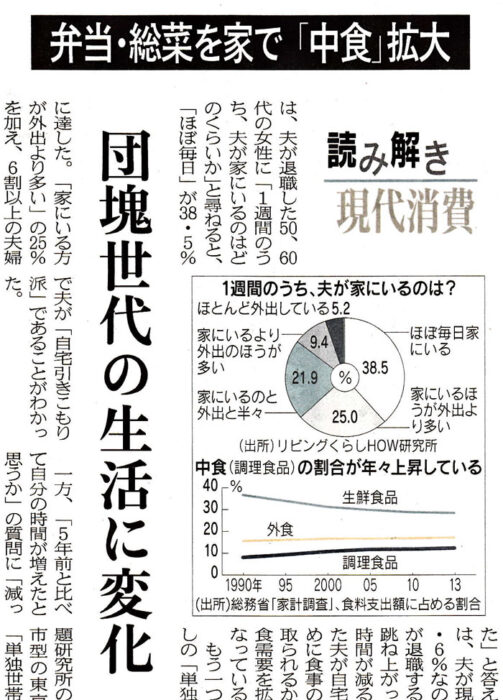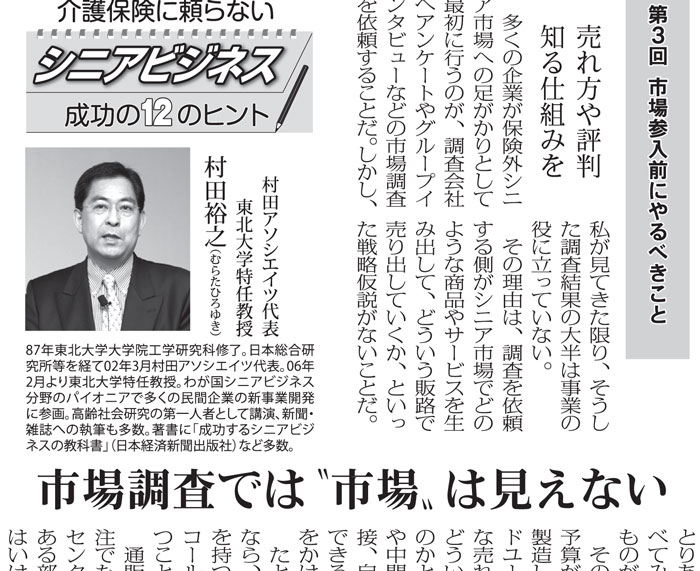South China Morning Post 2015年7月14日 Society
香港の有力英字紙South China Morning Postに「JAPAN MODEL ‘COULD SPUR BUSINESS’」(邦訳:日本モデルは香港の高齢化問題をビジネスで解決できるかも)と題して記事が掲載されました。
記事の内容は、7月3日に香港で開催された国際アクティブエイジングシンポジウムの際に受けた私へのインタビューがもとになっています。
香港の高齢化は韓国と並んで今後急速になり、高齢化率(全人口に対する65歳以上の割合)が33%になる年が、日本では2030年と予想されているのに対し、香港では2040年とスピードが加速しています。
その一方で香港での高齢化対策はほとんど準備ができていないと多くの識者が指摘しています。日本のような公的介護保険制度を導入すべきという人もいます。その理由として、リタイアした65歳以上人が要介護状態になった時に、高額な介護費用を自費で賄い続けることが不可能だと考えているからです。
しかし、この考えも重要なことが抜けています。つまり、公的介護保険制度を導入した時の財源をどうするかという点です。このあたりについては記事では私が話した日本の状況を引用しているだけで、論評はされていません。
むしろ、私が主張している「健全なシニアビジネスをどんどん増やし、高齢化の問題を税金投入ではなく、ビジネスで解決する」という考えが響いたようで、記事のタイトルが「JAPAN MODEL ‘COULD SPUR BUSINESS’」となったのも、それが理由と思われます。
記事の一番最後に「日本では若い人たちが介護の仕事を興味のある意義深い仕事だと思うようになってきている。その理由は人の生と死を目の当たりにして人生における多くのことを学べるから」という私の主張が掲載されたことに、この記者の方の良識を感じ、嬉しくなりました。
以下に記事全文を掲載します。
*****************************
JAPAN MODEL ‘COULD SPUR BUSINESS’
A Japanese expert in the science of ageing has revealed his country’s thriving silver-hair market was started by a nationwide elderly insurance plan launched 15 years ago – and says it sheds light on a possible future path for Hong Kong.
With an over-65 population of 33 million, Japan is the fastest ageing population in Asia and precedes Hong Kong by over a decade in this trend, said gerontologist Hiroyuki Murata.
Hong Kong, together with South Korea, will soon catch up. One in three Japanese will be over 65 in 2030; Hong Kong will reach that ratio in 2040.
“There was enough of a demographic shift that [elderly services and their products] were seen not as welfare but business,” said Murata in an interview with the Post.
Much of Japan’s quality private homes for the elderly were funded by the government medical insurance plan, with a now-lucrative silver-hair market worth an estimated 110 trillion yen (HK$7 trillion), he said.
The Japanese scheme is partly insurance-based and partly tax funded. Japanese start contributing to it when they turn 40.
However, the plan was getting very expensive and the government was trying to cut back on it, Murata noted.
Professor Nelson Chow Wingsun from the University of Hong Kong said there was an “urgent” need to launch a similar plan for the elderly in the city.
He said good nursing homes cost up to HK$30,000 a month, which was a burden for many people.
“How can ordinary people afford to pay HK$20,000 to HK$30,000 [a month] for private home care for around 10 to 20 years,” said Chow, adding that he was worried, though, about how a long-term insurance plan would be received.
“Realistically, people in Hong Kong are not even ready to pay for medical insurance,” he said, referring to doubts raised about the voluntary health insurance scheme put forward by the Food and Health Bureau last year.
Another issue that has come to the forefront in Japan is the provision of products that include exercise equipment, shoes, strollers, cellphones and electronic gadgets specifically tailored to the elderly.
Murata has worked with over 550 companies in developing products for elderly customers, including an age-friendly mobile phone with Japanese tech giant Fujitsu and telecoms company NTT Docomo.
The phone looks like a common mobile phone – only all the programmes, icons and texts are much larger, the dials and the applications are simpler and the sound is louder, Murata said.
In Hong Kong, Retiree and Senior Fair organiser Wilson Tong said the local market was also now offering products and services to “keep older people healthy” instead of just dealing with deterioration.
They sell more products like health foods, exercise equipment and life-enhancing products than traditional wheelchairs and walking sticks.
“The mindset of business operators needs to change,” said Murata.
“People now see that caregiving is an interesting and meaningful profession. Some young people like the job of a caregiver, because you learn a lot and you see the reality of life and death.”





